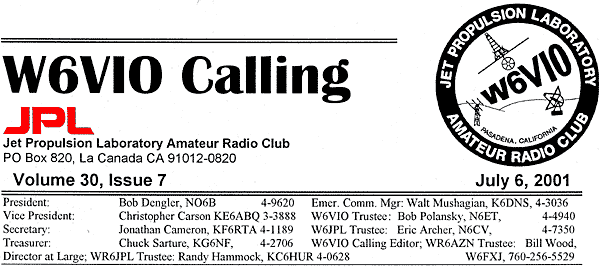
Permission to copy is
granted provided that credit is given to “W6VIO Calling.”
Contents
Calendar of Events
|
July
7 |
[Fontana Swap Meet,
A. B. Miller HS, Fontana] |
|
July
11 |
General Meeting,
Noon - 238-543 |
|
July
21 |
[CMRA Hamfest, Cal
Poly, Pomona, 7 AM] |
|
July 25 |
Board Meeting, Noon
- 233-305J |
|
July
28 |
[TRW Swap meet,
Redondo Beach] |
|
August
4 |
[Fontana Swap Meet,
A. B. Miller HS, Fontana] |
|
August
8 |
General Meeting,
Noon - 238-543 |
|
August
18 |
[CMRA Hamfest, Cal
Poly, Pomona, 7 AM] |
|
August
22 |
Board Meeting, Noon
- 233-305J |
|
August
25 |
[TRW Swap meet,
Redondo Beach] |
|
September
1 |
[Fontana Swap Meet,
A. B. Miller HS, Fontana] |
|
September
12 |
General Meeting,
Noon - 238-543 |
|
September
15 |
[CMRA Hamfest, Cal
Poly, Pomona, 7 AM] |
|
September
26 |
Board Meeting, Noon
- 233-305J |
|
September
29 |
[TRW Swap meet,
Redondo Beach] |
Meeting Notice
By Christopher
Carson, KE6ABQ
The July General Meeting of the JPL Amateur Radio
Club will be held in 238-543 on Wednesday, July 11th at 12:00 noon. Topics will
include the Field Day wrap-up and progress report on the new Shack.
The July Board Meeting is scheduled to be held on
July 25 in 233-305J. n
Prez’ Mix
By
Bob Dengler, NO6B
Has everyone
recovered from Field Day yet? While I
wasn’t up there for any of the operating, I understand that much fun was had by
all. The addition of a Motorola pass
cavity to my otherwise IMD-plagued FT-227 2 meter FM radio with a retrofitted
narrow IF filter really made for a near-perfect 2 meter FM station.
Unfortunately,
although both the equipment and operators on the VHF/UHF station did well,
apparently the activity on 2 meters was way down from previous years. I can only speculate that this is mainly
due to the ARRL’s continued ban on the use of 146.52 for Field Day
contacts.
This rule is
really starting to kill off FM voice as a substantial Field Day mode. The days of 350 plus FD contacts on 2 meter
FM are gone. In my opinion the only way
we’re going to bring them back is to first rescind the 146.52 ban, then go
around to all the local radio clubs and “talk up” 2 meter FM, getting all the
club members with only FM rigs to get back on 146.52 or 146.55 and give out FD
contacts.
If Field Day is
supposed to be a test of emergency communications preparedness and most local
hams only have VHF/UHF FM capability, why should there be rules that restrict
usage of popular FM simplex frequencies for making Field Day contacts? Without access to 146.52, Field Day stations
are unable to reach the multitude of stations in rural areas that frequent that
channel. This fact is evident in the
dramatic drop in 2 meter “FM DX” worked this year (stations over ~120 miles
away), and really takes the fun out of working VHF FM on Field Day.
To be sure,
there WAS a bit of FM DX worked by Tigran, KF6PVG, along with members of the
JPL Space Exploration Post 509 that attended our Field Day operation again this
year. There was a good AO-27 pass that
peaked about 5 minutes before the end of Field Day, and the SEP crew made the
most of it by working two contacts through the satellite’s FM repeater. One of those was in the East Bay section, so
that’s our FD FM DX for this year!
To top off this
month, I managed to stumble across one massive 15 meter opening the night of
June 29. Signals were not especially
strong here, but then again I’m not used to even hearing DX on my Gap vertical
antenna, let alone actually working it.
However, there was OK1CF, calling CQ DX on 21303 kHz and no one was
answering him, so I gave it a shot. To
my utter shock, he answered and gave me a 5-4 report. Remember, this is 15 meters at 10:30 PM local time. Then I found and worked HL0O/5 on Namhae
Island. By now it was past 11 PM and
time to go to bed, but had I continued I could have worked as many as 10
countries.
Before going to
bed, I looked out the window at my 24 ft. Gap Titan vertical planted 3 feet
above the ground in the back of my backyard and thought to myself “I just got
a 100 watt voice signal through to the Czech Republic with that dinky
antenna. Not bad.” 73.
n
June Meetings
By
Jonathan Cameron, KF6RTA
Special
Board of Directors Meeting, June 6
This extra Board
of Directors meeting was specially called by the club president, Bob Dengler
(NO6B). Those present included Bob
Dengler (NO6B), Bob Polansky (N6ET), Walt Mushagian (K6DNS), Randy Hammock
(KC6HUR), Jonathan Cameron (KF6RTA), and Bill Wood (W6FXJ, via phone). A quorum was present.
Bob Dengler
proposed a statement to be adopted by the JPL ARC favoring cooperation with
TASMA (the Two Meter Area Spectrum Management Association). This statement would commit the JPL ARC to
assisting the TASMA, including computer support. The motion was presented.
There was some discussion regarding the nature of the proposal and some
concerns about how it would fit into our situation here at JPL. So, the motion was tabled, pending further
consultation with other club members.
Bob Polansky
gave a detailed review of our status on the Field Day preparations. He indicated that things were shaping up
well, although there was some concern about getting enough help for Robb
Fredrickson, who is handling the food.
General
Meeting, June 13
The meeting was called to order at 12:10PM. Those present included: Bob Blakey (N6MTI), Jonathan Cameron
(KF6RTA), Bob Dengler (NO6B), Warren Dowler (KE6LEA), Robb Frederickson
(W1EEL), Randy Hammock (KC6HUR), Jay Holladay (W6EJJ), Walt Mushagian (K6DNS),
Bob Polansky (N6ET), John Repar (WA6LWD), Marc Sarrel (N70LI), Rob Smith
(W6GRV), and Marty Woll (N6VI).
Bob Dengler
presented a revised version of his statement for JPLARC support of TASMA. After some discussion, the modified TASMA
statement was accepted by a vote 6 to 3 (with 1 abstention).
Bob Polansky
gave an extensive presentation on the status of preparations for Field
Day. Everything looks ready.
Board
of Director’s Meeting, June 26
The
regular Board of Director’s meeting was not held. n
DX News
By Bob Polansky,
N6ET
I’ve been at
Field Day last weekend and at a Workshop all of this week, so this will be the
shortest article I can put together in the time remaining. Field Day was GREAT! Even managed to work three or four non-US
entities during the event. Got as far
away from Mount Gleason as HB9.
There’s been
very little time to do any listening with all the Field Day preparations taking
place this month. One item of
significant note: The Club put together
a PSK-31 station and operated it at Field Day on 10, 15, 20, and 40
meters. The crew managed on the order
of 50 QSO’s with the system and had contacts as far away as Australia with only
20 watts of output!
I’ve
reestablished the station in the W6VIO trailer and will be happy to work with
anyone wanting experience with the new mode.
If I’m not available, Dwight Holmes is now “a Club Expert” with
PSK-31.
Now for a
limited list of upcoming DX activities.
BENIN - A French
group will be operating from here from 11 through 29 August, all bands, all
modes. No call yet specified.
CAMBODIA - Look
for XU7ABR from 17 July through 2 August.
Specific frequencies are posted in The Weekly DX hanging on the W6VIO
trailer wall.
EQUATORIAL
GUINEA - 3C5J will be active through the end of October. I have one spot for him at 14033 kHz at
0615Z.
IRAQ - Rumor has
it that G0TLC will be operating from the YI1BGD Club Station from 28 June for
three weeks. Don’t miss this one!
MALPELO ISLAND -
HK5MQZ and HK5QGX are operating from the rare South American entity for an
undisclosed time. They’ve been active
on 40 through 10 meters, phone and CW.
MARKET REEF -
OJ0U will be active through 16 July.
All band, all mode operation should be taking currently taking place.
That’s
all I have time for. Good luck and good
DXing. n
Good-Bye to the BBC
World Service
Ever since I can remember (during World War II and
later), I have listened to shortwave radio.
It predated my ham radio career, and stumbling over hams talking on 20
meters while I was listening for new and rare shortwave broadcasts helped pique
my interest in ham radio.
Of course, the big voices in shortwave broadcasting
then were the BBC, the Voice of America, and later Radio Moscow. The Voice of America was unabashedly the
propaganda voice of the US (and mostly in non-English languages), but the BBC
was more of an English language news and entertainment service for British
expatriates and other English speaking people all over the world.
In those days, the service was called the “General
Overseas Service” and they transmitted news on the hour and features
continuously, 24 hours a day. Years
later, the name was changed to the “BBC World Service” but it continued with the
same unbiased news reports and entertainment.
In particular, I enjoyed Alistair Cooke’s “Letter
from America” where he presented a weekly essay on American politics and news
from a Brit’s point of view - very refreshing.
After more than 50 years, “Letter from America” is still part of BBC programming!
They say that the BBC World Service is so ubiquitous
and timely that while he was vacationing, Mikhail Gorbachev learned of his
replacement by Boris Yeltsin not from his aides, but from a BBC news broadcast
he was listening to. I can relate a
personal experience of my own.
While attending a CCSDS meeting in Toulouse, France
in 1986, we were watching the routine launch of another space shuttle on TV in
the hotel lobby. Suddenly something
went awry but none of us could understand the commentary in French. French TV repeated the explosion sequence ad
nauseum with excited commentary, but we still didn’t have any details we could
understand.
Some of us tried to phone NASA Washington or Houston
but ALL phone lines were busy. I went
to my room, pulled out my trusty book-size shortwave radio and immediately
found out from the BBC that Challenger had exploded, broken apart, and crew
survival was unlikely. At dinner that
night a prayer was offered by our French hosts for the lost American Astronauts. Some of us stayed around the little radio
late into the night as the gloomy reports came in through the BBC. At least we knew what was going on.
Now I am sad to report that as of July 1, the BBC
has curtailed all shortwave transmissions directed to Canada, the US, Australia
or New Zealand. The reason given is
that these countries are so advanced that the BBC feels local FM stations can
relay the BBC programming, and since most of the USA is computer-literate and
connected to the internet, listeners there can hear the programming as either
stored or streaming audio from the BBC servers on the World Wide Web.
Possibly more to the point, Mark Byford, Director of
the BBC World Service, wants to reallocate his budget to spend less on shortwave
directed to these progressive regions so he can spend more on shortwave
broadcasts to the more primitive areas of the world where shortwave radio is
basically the only method available to reach the people.
You can imagine that this is a traumatic event for
many of us who have lived with, and relied upon, the BBC for decades. Byford feels shortwave listening in the US
is dwindling, while hits on his web site are increasing, so he wants to jump on
the new technology right away and save a bundle of money.
Unfortunately, the World Wide Web doesn’t reach my
camping site on the Colorado River just yet - there isn’t even cell phone
coverage there! Moreover, after
sitting at a computer screen for hours all day I don’t relish sitting even more
to hear a streaming audio broadcast.
Byford says we can get the BBC on local FM broadcast
stations, which is true - there are four or five FM Public Radio stations that
carry the BBC in California - but what do you do in between their coverage
areas? In addition, if you look at
their program schedules, the limited relays of BBC programs air at inconvenient
hours such as midnight to three am.
That’s very different from the hourly news I used to get throughout the
day anytime on shortwave!
I suggested that the BBC should do more to encourage
shortwave listeners in North America instead of complaining about dwindling
shortwave listenership. And since
digital broadcasting isn’t too far in the future, they may be sorry they
withdrew
from the top gun position in a market that may be on the verge of exploding
with new technology.
I wrote him a letter urging him to delay the
shortwave shutdown for at least a couple of years, until the status of
technology
in the USA catches up with his vision of alternative access such as FM relays
or internet. Then, on my recent birding
trip to the Shetland Islands, I stopped in London and hand carried the letter
to his BBC office in Bush House. Of course, it didn’t help; the shutdown
occurred
on schedule, but at least I am content that I tried!
Meanwhile, the good news is that they haven’t shut
down the entire BBC World Service. They
admit it may still be possible to hear their programs in North America as
spillover from programming directed elsewhere, such as Central and South
America or Asia.
If you’d like to try to listen
to the BBC World Service today, they recommend the following frequencies for
North America, although the strength and quality will not be as good as
formally:
5975 kHz 2300 to 0400 GMT
9915 kHz 0000 to 0300 GMT
12095 kHz 2100 to 0300 GMT
15220 kHz 1100 to 1400 GMT
17840 kHz 1400 to 1700 GMT
The best reception for Western North America will be
in the morning from their East Asia broadcasts:
9740 kHz 1100 to 1600 GMT
9815 kHz 1200 to 1500 GMT
11955 kHz 1100 to 1300 GMT
15280 kHz 1100 to 1300 GMT
You can get more information on
the shutdown, as well as programming in stored and streaming audio form, from
the BBC’s World Service web site: http://www.bbc.co.uk/worldservice/
then click on “Shortwave Changes.” n
Classified Section
Wanted:
Reliable on-lab person to receive about 40 copies of
“W6VIO Calling” each month to address and mail to retired and other off-lab
club members. Job involves applying
club supplied adhesive address labels and postage stamps. Takes only 30 minutes each a month. Contact Bill Wood, W6FXJ, at 760-256-5529 or
w6fxj@earthlink.net for details.
Your want-ad or article for inclusion in a future
issue of W6VIO Calling. Submit to Bill
Wood, W6FXJ, 31094 Hemlock Ave, Barstow, CA
92311; or email w6fxj@earthlink.net
For Sale:
Kenwood TS-940S
base HF radio w/automatic tuner, MC-60 microphone, SP-230 speaker & MFJ 300
watt dummy load. Asking $850 or trade
for FT-100D. Contact Bob at
909-396-0991 or no6b@rptrlist.w6jpl.ampr.org.
Kenwood TM-G707A
2 meter/440 dual-band mobile (single band receive). 50 W 2 meters/35 W 440, CTCSS decoder modified to eliminate
falsing problem common with all G707s & V7As. Original/only owner, asking $260. Contact Bob at 909-396-0991 or no6b@rptrlist.w6jpl.ampr.org.
QST 1990-1994 CD-ROM set, new. $25 (ARRL price $39.95) Skip, W7NWY,
818-354-9674
Icom UT-40 Tone Squelch Option Board (CTCSS) for HT
models 2GAT, 4GAT, 12GAT, 32AT or for mobiles 228, 448, 901, 1201, 2400 and
2500. Cost: $80 (AES Catalog) Sale for $40. Radio Shack, Rotor/Controller and Cable, 3 years old, never used,
have box/papers, like new. Cost: $70+
Sale for $50. Scott Nolte, N6CUV
818-354-9724. n
Field Day, 2001
By Jay Holladay, W6EJJ
The JPL ARC Field Day operation for 2001 took place
atop Mt. Gleason on June 22-24. The
weather cooperated nicely and we managed a good score despite some
difficulties with tower trailers, antennas, and generators.
Highlights included a digital station operating the
PSK-31 mode, a satellite station operated by members of Explorer Post 509, APRS
and portable packet demonstrations, and stations for VHF FM, Novice/Technician,
and 6-meter SSB. Great conditions on
20-meters and dedicated operators allowed us to keep three HF stations
operating for the full 24 hours. The
kitchen operation kept us all well fed thanks to Robb Fredrickson and his able
crew.
We tried
a number of new and innovative approaches to raising the large HF antenna
arrays, thanks to much hard work by Warren Dowler and Marty Woll. Having one array per tower and not having to
climb the towers were definite plusses.
As might be expected, not everything went as planned, but in true Field
Day fashion the problems were solved and eventually the antennas were flying.
During the 24-hour operation, we also worked our way
through three generators, the last of which did not provide enough power for
the entire site. Therefore, we reduced
power and kept on making contacts. At
least that generator did get us through to the end of the operation.
Overall, a real test of equipment and operators
under difficult conditions – fulfilling the main objective of Field Day!
We operated in Class 6A for the first time to give
more opportunities for everyone to participate. Initial results tallied just after the contest showed a total of
3515 contacts that, with bonus points, should yield a score of more than 11,000
points. A very respectable effort,
which under the circumstances, gave everyone involved a real feeling of
accomplishment. n
Field Day
Scrapbook
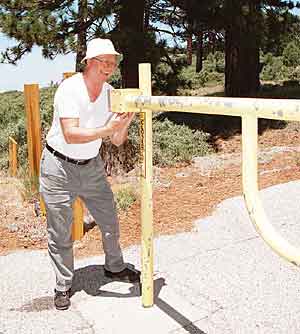 |
|
Bob, N6ET, unlocks the gate at Mt.
Gleason |
 |
|
Unloading the step van Friday
Afternoon |
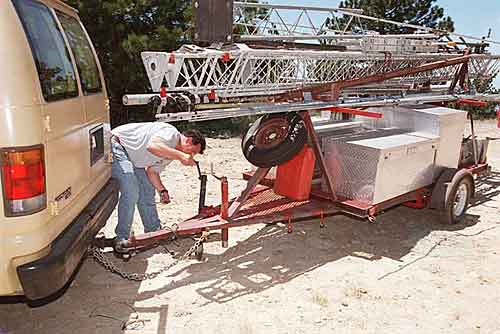 |
|
Dave Ritchie positions the
generator/tower trailer |
 |
|
Setting up the pneumatic tower
with the 40-meter beam |
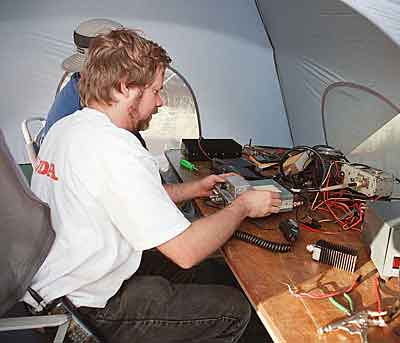 |
|
Bob Dengler, NO6B, Sets up VHF
Station |
 |
|
Chef Robb Fredrickson, dishes up
Friday Night Chow |
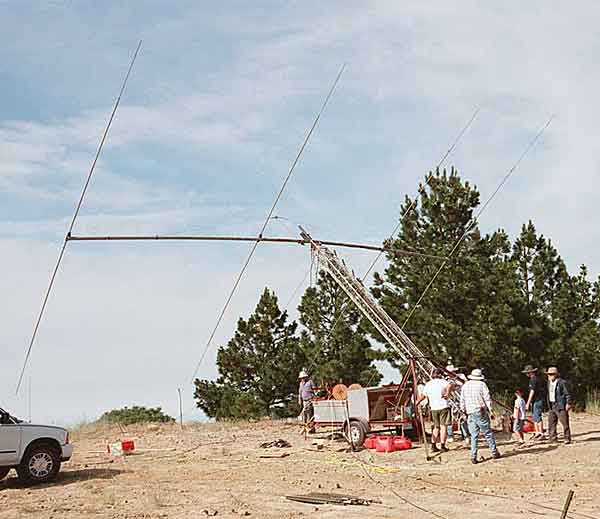 |
|
Tilting up the 20-meter beam tower Saturday Morning |
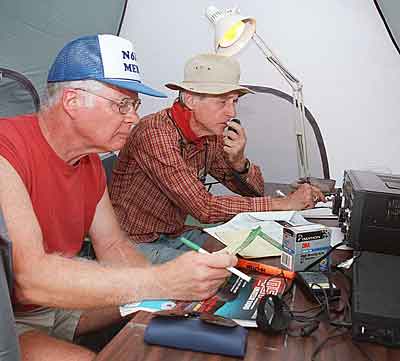 |
|
Merv. N6NO, and Jay, W6EJJ, start
racking up QSO’s |
 |
|
Dave, WD6V, Aeronautical Mobile,
drops in for an eyeball QSO! |
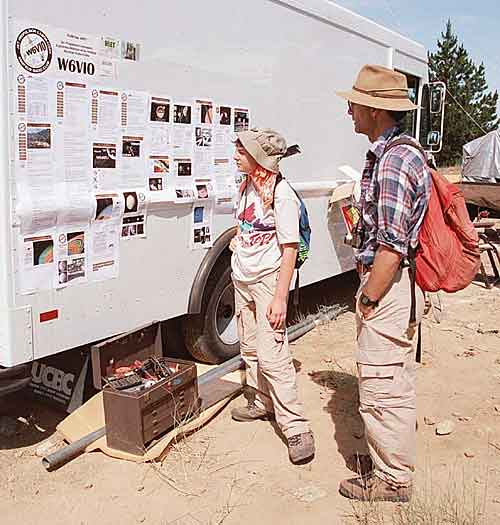 |
|
Visiting hikers check out the
Field Day Information Display |
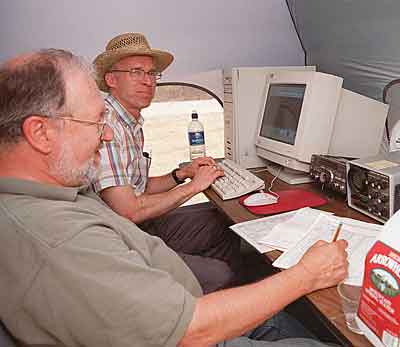 |
|
Dwight Holmes, WA3NPK, (foreground) and Bill Weber, N6CI,
operating the W6VIO digital station. Using the new PSK-31 mode, they
managed
46 contacts on four HF bands. |
 |
|
Merv MacMedan, N6NO, Collecting CW
Contacts |
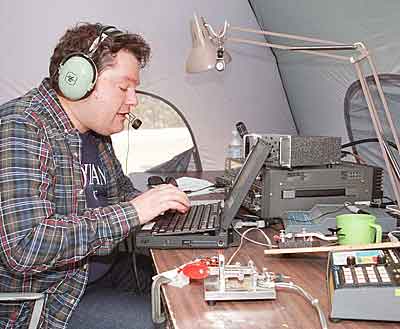 |
|
Rob Smith, W6GRVm, works the
pileups on 20-meters |
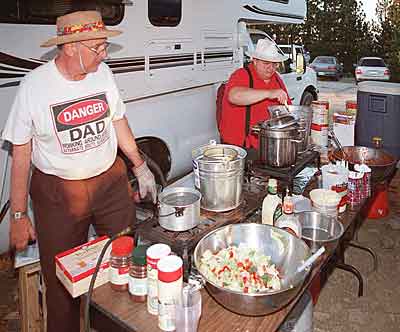 |
|
Robb Fredrickson, W1EEL, and
Jonathan Cameron, KF6RTA, serve the Saturday night spaghetti dinner |
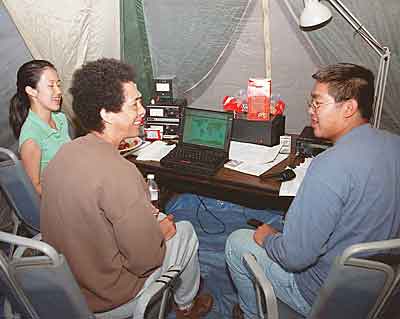 |
|
Advisor Judy Nelson
(center) with Explorer Post 509 members Jui-Shan Grace Hsu and Matthew Tsang,
KG6CLU, at the W6VIO satellite operating position |
 |
|
Explorer Post 509
advisors Tom Wolfe with Tigran Karsian, KF6PVG, at the Novice/Technician
station, KC6HUR |
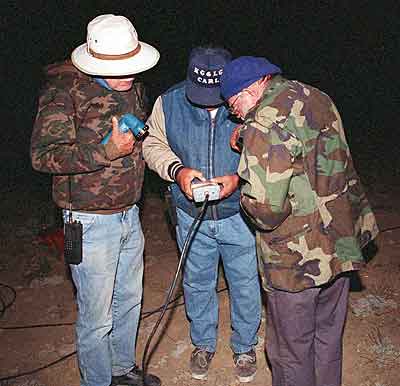 |
|
Walt, K6DNS, Carl, KG6LG, and
Warren trouble-shoot a cable problem |
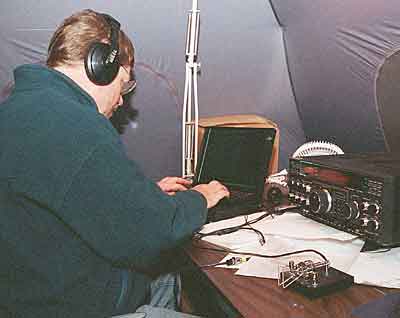 |
|
Marty Woll, N6VI, works the night
shift |
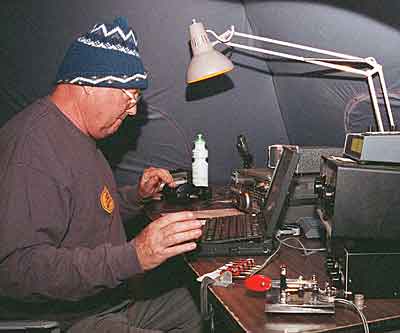 |
|
Bob Polansky, N6ET, Racking up CW
QSO’s Saturday Night |
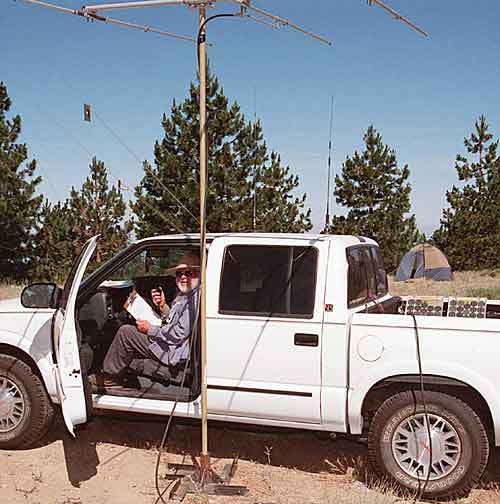 |
|
Warren Dowler, KE6LEA, Making 6-meter Solar powered contacts |
Newsletter Deadline:
Friday, July 27 for the August issue of W6VIO Calling. Your articles, ads, photos, diagrams,
letters to the editor, or technical material should be submitted to the
editor via email (w6fxj@earthlink.net)
or regular mail to: Bill Wood, 31094 Hemlock Ave, Barstow, CA 92311.







